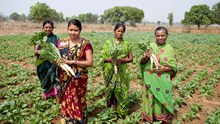
World Environment Day 2025: Every year on June 5, millions of people around the world come together to celebrate World Environment Day, the flagship event of the United Nations aimed at raising awareness and promoting action for environmental issues. Since its inception in 1973 by the United Nations Environment Programme (UNEP), World Environment Day has grown into the largest global platform for environmental outreach.
In 2025, the event will be hosted by the Republic of Korea, focusing on the urgent theme: "Ending Plastic Pollution." This year's emphasis is on combating one of the most visible and damaging environmental challenges—plastic pollution.
Why Focus on Plastic Pollution in 2025?
Plastic pollution is no longer just an eyesore. It has become a global crisis, threatening the health of our ecosystems, wildlife, and even humans. Over the past few decades, plastic waste has reached even the most remote parts of the planet—from deep ocean trenches to Arctic ice.
The problem is growing rapidly. Around 11 million tonnes of plastic waste enter aquatic ecosystems each year. This number is expected to increase if urgent action is not taken. Most plastics take hundreds of years to decompose, breaking down into microplastics that spread through water, air, and soil.
Hidden Threat: Microplastics
Microplastics are tiny particles of plastic, smaller than 5 millimeters, that are now found almost everywhere. They come from two sources:
-
Primary microplastics: Made to be small, like microbeads in face washes and cosmetics.
-
Secondary microplastics: Formed by the breakdown of larger plastic items like bags, clothes, tires, and packaging.
These tiny plastics are now present in our food, water, and even the air we breathe. Research has shown that humans might be consuming tens of thousands of microplastic particles each year. Even more alarming, microplastics have been detected in human organs and blood vessels.
Plastic Pollution: A Triple Threat
Plastic pollution contributes directly to what scientists call the triple planetary crisis:
-
Climate Change – Plastics are made from fossil fuels, and their production, transport, and disposal release greenhouse gases. When burned or left to degrade, plastics emit CO₂, methane, and other harmful gases, worsening global warming and making climate goals harder to reach.
-
Biodiversity Loss – Plastic waste harms wildlife. Animals eat plastic or get entangled in it, leading to injury or death. Entire ecosystems, especially oceans and forests, are being disrupted, pushing many species toward extinction.
-
Pollution and Waste – Plastic clogs drain, pollutes water bodies, and ruins soil health. Poor waste management lets plastic leak into cities, rivers, and farmland, creating health, sanitation, and agricultural problems.
Studies also show that microplastics can reduce soil fertility, affect crop production, and even speed up ice melting in polar regions, worsening climate impacts. They’re also entering the human body, raising serious health concerns.
Global Action and the Plastic Treaty
In response to the growing crisis, countries have been working on a Global Plastic Pollution Treaty. In November 2024, the Republic of Korea hosted the fifth round of negotiations, and discussions will continue in August 2025 in Geneva, Switzerland.
This treaty aims to establish legally binding commitments to reduce plastic production, improve waste management, and promote recycling and product redesign globally.
What Can Be Done to Fight Plastic Pollution?
Ending plastic pollution is challenging but achievable if we take the right steps. Here’s what we can do:
-
Say no to single-use plastics like straws, bags, and disposable cutlery.
-
Choose reusable alternatives made from cloth, metal, or glass.
-
Buy clothes made of natural fibers to reduce microplastic shedding.
-
Support recycling efforts and proper waste disposal.
-
Avoid products with microbeads—read labels carefully.
-
Push for government policies and regulations to ban harmful plastics and invest in recycling infrastructure.
This year’s campaign under the slogan #BeatPlasticPollution is not just about raising awareness, it’s about driving real change. Through global cooperation, scientific research, and policy action, we can create a future with cleaner oceans, healthier ecosystems, and safer environments for all.
World Environment Day 2025 is a powerful reminder that the fight against plastic pollution is not a choice, it’s a necessity. Each of us has a role to play. Together, we can turn the tide.















